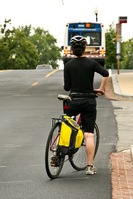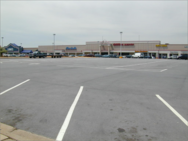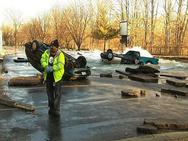CSG’s 2011 State of the Washington Region

Photo by Bill Adler.
Last week, you heard from both President Obama and the Republican leadership about our nation’s challenges and opportunities. Today, we at the Coalition for Smarter Growth wanted to share with you the state of our communities and our region.
2010 was a great year for planning and creating the vibrant, walkable, bikeable and transit-oriented communities that are in such high demand. Great new plans passed for Tysons Corner, White Flint, New Carrollton, Potomac Yard, and Crystal City.
Fairfax County made transit communities a top development and environmental priority. Property values for urban and transit communities held up well in the real estate market despite the recession. And our outer suburbs began incorporating more smart growth principles into their community planning.
One of our biggest victories in recent years came when we saved Metro rail and bus service. Working with hundreds of you, we emailed and petitioned Metro’s decision makers and our elected officials on behalf of Metro.
The District saw several pedestrian safety victories, and DC and Arlington launched Capital Bikeshare, the new (yet already wildly popular) bikesharing service. If you’d like to read more about what happened last year, take a look at our Top five Smart Growth moments of 2010.

Photo by Jon Reaves.
Looking ahead in 2011
Today, our region is at a crossroads. There are several directions our region could take as we envision our future. But there is one path we simply can’t afford to take: the direction toward more traffic and mounting infrastructure bills. For too long the government and private sectors have made decisions that snarl our commutes and cost us billions.
Highlighted in the Washington Post story Five things that keep Stewart Schwartz up at night, these decisions include where we’re choosing to put our jobs — decisions like BRAC and Science City, hospitals and museums locations, and corporate headquarters.
We’re not the first to say it, but it’s time for fundamental change, and there’s never been a better time for it. We live in our nation’s capital, and it’s time we become an example of innovation, problem solving, fiscal and environmental sustainability and prosperity for the rest of the country.
With limited available funds, we can’t afford a continued business-as-usual approach where tax dollars are spread around like peanut butter. Throwing money at transportation without focus, whether it’s through massive borrowing and debt in Virginia or a gas tax increase in Maryland, is inefficient and irresponsible.
Instead, we must target our infrastructure investments and prioritize a fix-it-first policy that will repair and replace aging bridges, pavement, and transit. We need to tie our investments to supporting transit-oriented, mixed-use walkable/bikeable communities, which can mean more money spent on local “complete streets” networks as well as transit, pedestrian and bicycle facilities. We can also invest in operational improvements, such as better traffic incident response and coordination, expanded HOV, and bus priority lanes.

Top 5 opportunities in 2011
Looking ahead, there are five key opportunities we must take advantage of in order to secure a sustainable, competitive future for our communities. We call on our region’s residents, decision makers, and our elected officials to join us as we move our region forward:
- Metro: The fight for Metro is not over, but we’ve won every battle so far. This year, we can and should find the means to fully fund Metro’s operating and capital investment needs in order to avoid further fare increases and service cuts. Increased ridership over the past several years proves that investment in this critical transportation system is well worth it, especially in bus priority services that improve on-time service and carry more passengers at less cost.
- Transit-oriented development: 2010 was the year for great TOD plan approvals, but there’s more work to be done. Prince George’s County has 15 Metro stations that are ripe for development, and Montgomery’s eastern stations and Shady Grove have all the right ingredients for successful TOD communities. Now we have to get the details right on plans that have already been approved, and work with elected officials to get started on areas that don’t yet have plans in place.
- Mixed-use commercial corridors: Demand is visibly increasing for revitalizing our commercial corridors throughout the region, including Route 1 in Fairfax County, Route 234 and 28 in Manassas, Rockville Pike in Montgomery County, and the Central Avenue Corridor in Prince George’s County. Let’s channel this demand by working with elected officials and communities to help suburbs focus their growth and reduce traffic through more interconnected, mixed-use communities.
- Housing options: A wide variety of housing options is essential for healthy, balanced communities, access to jobs, and reduced traffic. In 2011, we must ensure every community throughout the region has a full range of affordable housing choices through mixed-use revitalization, housing trust funds, affordable housing preservation strategies, and inclusionary zoning policies. There are even tools like the Housing + Transportation Cost Calculator and Walk Score to help find and create more convenient and affordable communities.
- Transportation: One-sided proposals for transportation that throw money at the problems don’t make sense. It’s time for a summit of civic, conservation, housing, business, and government leaders to come together and work on a more sustainable transportation (and land use!) plan and appropriate funding strategies that benefit everyone.

Photo from NBC Washington.
The nation’s challenges are also our challenges
The problems in the Washington region are no different than those across the country. Aging infrastructure, huge federal debt, climate change, energy inefficiency, oil dependency, and severe strains on household budgets are all challenges that we must face in 2011, no matter where we live. Smart growth solutions will help us address these challenges.
- Aging infrastructure: Aging infrastructure makes us less efficient and less safe. Right now, we’re facing the task of fixing exploding 50-year-old water mains, $3.5 billion in structurally deficient bridges in Virginia, old schools, and a 35-year old Metrorail system. Before we make new investments, we must remember our old ones and use a fix-it-first policy to improve infrastructure.
- Federal febt: Federal debt means less money available for infrastructure. In fact, many would agree that our nation is broke. Therefore, we cannot afford to subsidize inefficient sprawling development with new infrastructure while trying to maintain the old. We must instead make redevelopment and revitalization in existing communities a top priority, allowing public and private sectors to share the cost of replacing and upgrading old infrastructure. By focusing public resources for water and sewer, transportation, housing, stormwater and other infrastructure on redevelopment and economic development incentive programs in a coordinated way, our tax dollars will be used more efficiently.
- Energy consumption: The US comprises just 5% of the world’s population but consumes 25% of the world’s oil and generates the largest share of CO2 emissions from automobiles. 65% of our oil is imported. Reducing our energy consumption seems like a daunting task, but already communities across the country are reducing their emissions by creating green, mixed-use, mixed-income, walkable/bikeable and transit-oriented communities. Part of that is making investment in transit, intercity rail, and local street networks a top national, state, and regional priority.
- Strained household budgets: Household budgets are strained and the combined high cost of housing and transportation is a top contributing factor. Like reducing energy consumption, we can reduce our budget burdens by creating walkable, mixed-income, mixed-use, transit accessible communities that offer the opportunity for shorter commutes, fewer daily car trips, less traffic, and greater energy efficiency. In Washington specifically, we must continue to address the east-west jobs/housing divide, create more housing options closer to jobs, and make residential and commercial building energy efficiency a top priority.
Let’s lead!
We can’t say it enough: 2010 was a great smart growth year. But as we begin to choose our path for 2011, let’s take what didn’t work last year and create new opportunities.
Adopting a range of smart growth policies — from transit-oriented development to a range of housing options — will set us firmly on a course to become the most energy efficient, and environmentally and fiscally sustainable region in the nation. In the process we will help address some of the great challenges we face nationally and become a model for the rest of the country.
Laura DeSantis is the Online Advocacy and Outreach Specialist for the Coalition for Smarter Growth.
